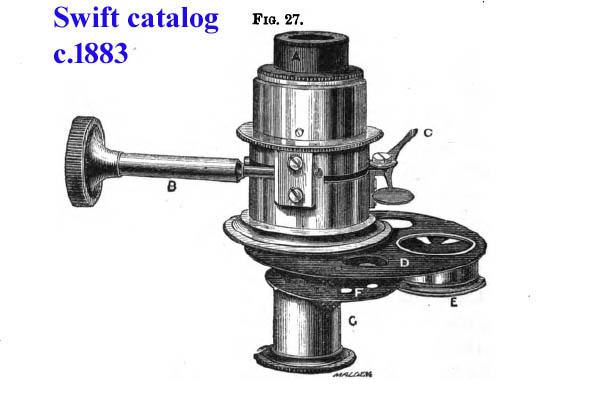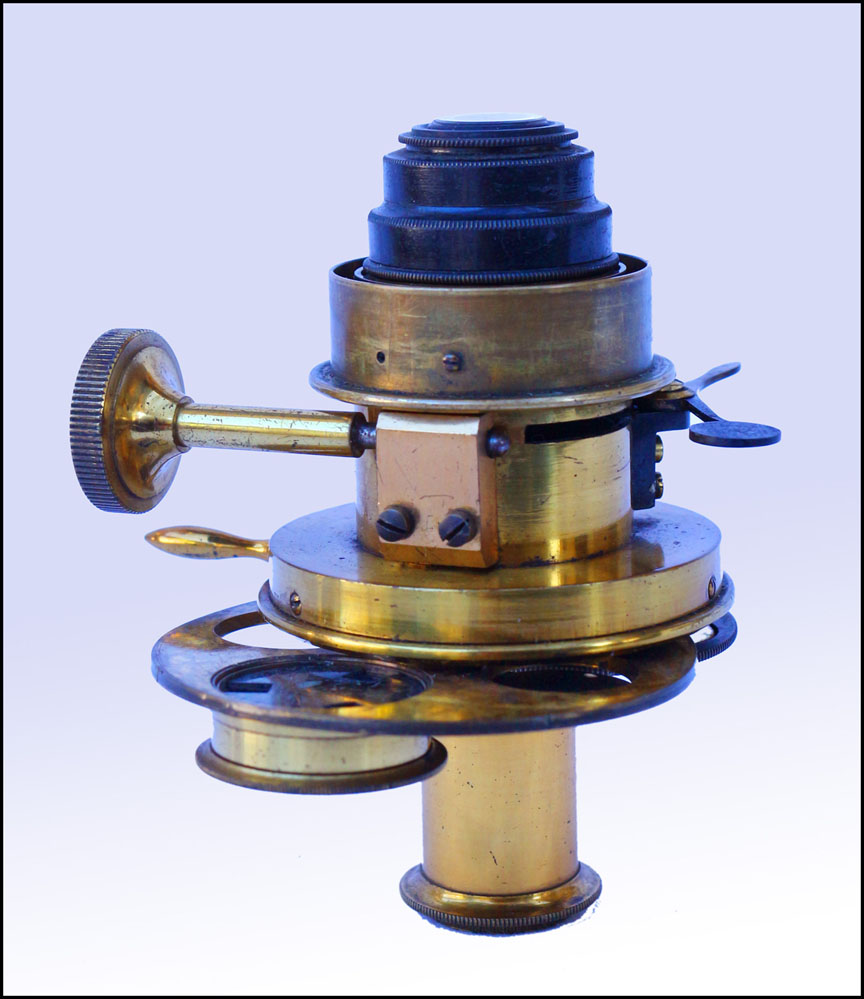COMPOUND FOLDING PORTABLE BINOCULAR POLARIZING MICROSCOPE
MAKER: JAMES SWIFT & SON
c. 1895
DESCRIPTION:
This is a very well preserved example of a Swift Binocular Folding Portable compound microscope. The tripod stand is fitted with folding legs. The V-shaped rear leg has a square pad bottom, while the two front legs have round pad bottoms. The axis for the folding legs serves as the inclination joint as well. Tension on the inclination joint can be tightened with a screwdriver, not requiring a spanner wrench like some other models.
The plane and concave mirror is in a gimbaled mount which attaches via a short extension to a ring that rides on the dedicated tailpiece. A understage ring accepts the condenser which has a pin which slides in and locks in place with a slight rotation counterclockwise.

 The condenser is Swift's improvement in Hall's condenser originating in 1868, and slightly modified after 1870. Swift referred to it as his
The condenser is Swift's improvement in Hall's condenser originating in 1868, and slightly modified after 1870. Swift referred to it as his Popular Achromatic and Tinted Condenser
. In the Swift 1876 catalog it states that this improved form of 1870 was initially devised specifically to be the condenser for his Binocular Portable Microscope.
This version of the Hall condenser available after about 1870 was a slight improvement with a lever controlled dark ground stop instead of a slider for dark field stops. In addition, an iris diaphragm was, for additional cost, an option; this option is present on the example with this microscope.
The condenser has an integrated rack and pinion focus for its lenses.The main wheel at the bottom of the condenser carries a variety of accessories. A subsidiary wheel, mounted to the main wheel carries disc with three apertures, two of which carry selenites with the third open; the fixed polarizer sits below this subsidiary wheel. Another subsidiary on the main disc is a short rotatable cylinder in which a three-slotted disc is fitted for oblique illumination. In addition to these two provisions, the main wheel has an unoccupied opening and an opening with a round shutter which provides a variable crescent allowing variable oblique lighting. An additional accessory is a diffusing cap that press-fits to the top of the condenser to provide even illumination at low powers.
Swift developed another variation of this condenser called the Universal Condenser
around 1874. This took advantage of rack and pinion substages. For further information please see the history section about the Swift Universal Achromatic Condenser.
The Popular Achromatic and Tinted Condenser
, was supplied in its original form from 1868 to 1870; after that, both the Popular in its improved form, and the Universal, were both offered in the Swift catalogs from 1874 to about 1910.
The stage has two stage clips over ivory slide rests to allow easy position of the slide. The stage can fold, a feature not needed with the case it is in, but might be needed with a smaller case like the leather ones supplied later.
Coarse focusing is by rack and pinion and fine focusing is via a finely threaded screw acting on the Continental-Style limb.
The binocular tube has a Wenham prism that can be slid out of the optical axis and also has an Ahrens prism analyzer on a slider. Interocular distance is adjusted by rack and pinion to the binocular tubes.
Accessories include four
Swift objectives, five Swift eyepieces, a live box, and a wooden travel case. The black painted hardwood case has chamois-covered cotton cushions to protect the microscope in transit. It has a hinged top and front for easy access with a drawer for additional accesories and slides.
HISTORY:
This is a transitional model of Folding Binocular Compound Microscope, probably from about 1897. For the history of Swift Folding Portable Microscopes please the the history section of the Swift Improved Clinical, Zoologist, & Field
model.

 The condenser is Swift's improvement in Hall's condenser originating in 1868, and slightly modified after 1870. Swift referred to it as his
The condenser is Swift's improvement in Hall's condenser originating in 1868, and slightly modified after 1870. Swift referred to it as his